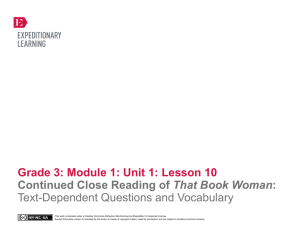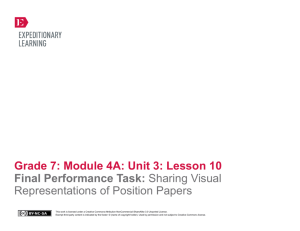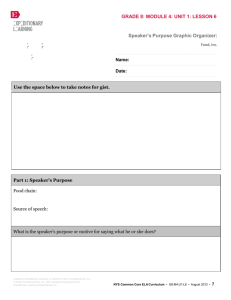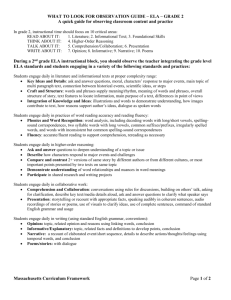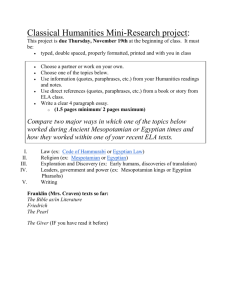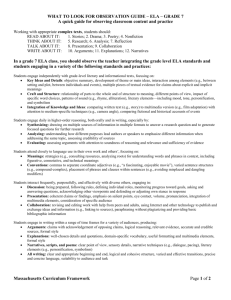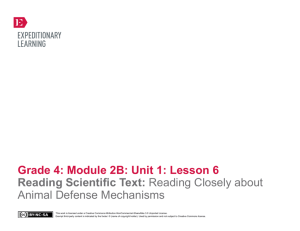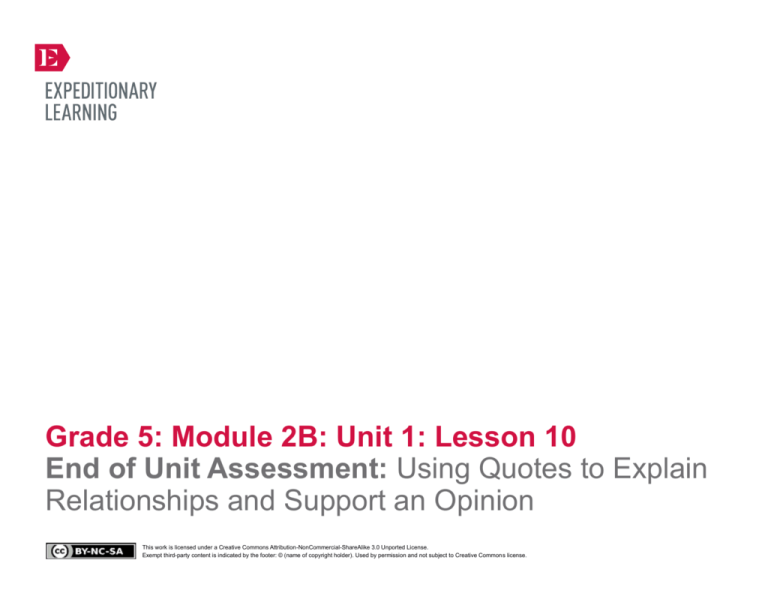
Grade 5: Module 2B: Unit 1: Lesson 10
End of Unit Assessment: Using Quotes to Explain
Relationships and Support an Opinion
This work is licensed under a Creative Commons Attribution-NonCommercial-ShareAlike 3.0 Unported License.
Exempt third-party content is indicated by the footer: © (name of copyright holder). Used by permission and not subject to Creative Commons license.
GRADE 5: MODULE 2B: UNIT 1: LESSON 10
End of Unit Assessment:
Using Quotes to Explain Relationships and Support an Opinion
Long-Term Targets Addressed (Based on NYSP12 ELA CCLS)
I can determine the meaning of words and phrases as they are used in a text, including figurative language such as metaphors and similes. (RI.5.4)
I can quote accurately from a text when explaining what the text says explicitly and when drawing inferences from the text. (RI.5.1)
I can explain the relationships or interactions between two or more individuals, events, ideas, or concepts in a historical, scientific, or technical text based on specific
information in the text. (RI.5.3)
I can compare and contrast the overall structure (e.g., chronology, comparison, cause/effect, problem/solution) of events, ideas, concepts, or information in two or more
texts. (RI.5.5)
I can write opinion pieces on topics or texts, supporting a point of view with reasons and information. (W.5.1)
a. Introduce a topic or text clearly, state an opinion, and create an organizational structure in which ideas are logically grouped to support the writer’s purpose.
b. Provide logically ordered reasons that are supported by facts and details.
Supporting Learning Targets
Ongoing Assessment
• I can determine the meaning of unfamiliar words and phrases using a variety of strategies.
• I can analyze the way text is structured to support readers’ understanding of complex ideas.
• End of Unit 1 Assessment: Using Quotes to Explain
Relationships and Support an Opinion
• I can write an opinion paragraph to explain which invention has been most important to people.
• Tracking My Progress: End of Unit 1 recording form
• I can reflect on my learning about how new or improved technologies are developed to meet societal
needs.
• Independent Reading Choice Board response
Copyright © 2013 by Expeditionary Learning, New York, NY. All Rights Reserved.
NYS Common Core ELA Curriculum • G5:M2B:U1:L10 • June 2014 •
1
GRADE 5: MODULE 2B: UNIT 1: LESSON 10
End of Unit Assessment:
Using Quotes to Explain Relationships and Support an Opinion
Agenda
Teaching Notes
1. Opening
• The end of unit assessment is “open book”: Students may use all of their texts, notes, and other written
resources. However, they must work independently unless otherwise indicated by an IEP or other
formal learning plan.
A. Reviewing Homework and Engaging the Reader (5
minutes)
B. Reviewing Learning Targets (5 minutes)
2. Work Time
A. End of Unit 1 Assessment: Using Quotes to Explain
Relationships and Support an Opinion (35 minutes)
B. Tracking My Progress: Reflecting on Learning (10
minutes)
3. Closing and Assessment
A. Debrief: Sharing Reflections on Learning Targets
and Exit Ticket (5 minutes)
4. Homework
A. Fluency Practice
• Students should also have completed the last square on their Independent Reading Choice Boards (from
Lesson 1), “What qualities will you look for in the next book you read?” Find time during the day to meet
with individual students to discuss their reflections. Students will have an opportunity to choose a new
independent reading text in Unit 2, Lesson 1. For students who are not finished reading their first text,
ask them if they would like to continue reading the book or if there may be a better choice for them,
based on their responses to questions from the choice board. If students would like to continue,
consider assigning an alternate task such as ways to build fluency skills related to accuracy, rate, and
expression.
• In advance:
– Review the End of Unit 1 Assessment: Using Quotes to Explain Relationships and Support an Opinion
and the assessment texts “Big Thinkers” and “Steve Jobs.”
– Be sure students have access to their own version of the articles “The Electric Motor,” “Dr. Naismith,
Inventor of Basketball,” and “First College Basketball Game.”
– Display the following anchor charts from Lessons 1–9 for student reference during the assessment:
Close Readers Do These Things and Vocabulary Strategies.
– Review Four Corners protocol (see Appendix ).
Copyright © 2013 by Expeditionary Learning, New York, NY. All Rights Reserved.
NYS Common Core ELA Curriculum • G5:M2B:U1:L10 • June 2014 •
2
GRADE 5: MODULE 2B: UNIT 1: LESSON 10
End of Unit Assessment:
Using Quotes to Explain Relationships and Support an Opinion
Lesson Vocabulary
Materials
determine, variety, strategies, analyze,
structured, complex, opinion,
invention
• Four Corners sheets (post each one in a different area of the room)
• Journals (students’ own, begun in Lesson 1)
• “The Electric Motor” (from Lesson 7; one per student)
• “Dr. Naismith, Inventor of Basketball” (from Lesson 9; one per student)
• “First College Basketball Game” (from Lesson 9; one per student)
• Close Readers Do These Things anchor chart (from Lesson 1)
• Vocabulary Strategies anchor chart (from Lesson 2)
• “Big Thinkers: Was Steve Jobs This Generation’s Thomas Edison?” (assessment text; one per student)
• “Steve Jobs” (assessment text; one per student)
• End of Unit 1 Assessment: Using Quotes to Explain Relationships and Support an Opinion (one per student)
• Tracking My Progress: End of Unit 1 recording form (one per student)
• Index cards (one per student)
• Independent Reading Choice Board (one per student)
Copyright © 2013 by Expeditionary Learning, New York, NY. All Rights Reserved.
NYS Common Core ELA Curriculum • G5:M2B:U1:L10 • June 2014 •
3
GRADE 5: MODULE 2B: UNIT 1: LESSON 10
End of Unit Assessment:
Using Quotes to Explain Relationships and Support an Opinion
Opening
Meeting Students’ Needs
A. Reviewing Homework and Engaging the Reader (5 minutes)
• Review the Four Corners protocol with students. Provide clarification as needed.
• Provide sentence frames to support
students during group discussions:
“I think ____ is most important
because the article about ____ says
____.”
• Then, focus students’ attention on each of the Four Corners sheets:
– “Basketball met the greatest societal need.”
– “Windshield wipers met the greatest societal need.”
– “The paper bag machine met the greatest societal need.”
– “The electric motor met the greatest societal need.”
• Ask students to think about the articles they read about each of these inventions, and then determine which invention met
the greatest societal need.
• Once students have made a decision, direct them to stand near the Four Corners sheet that reflects their choice.
• Give students 2 or 3 minutes to discuss with other students at the same sheet why they believe that particular invention met
the greatest societal need. Encourage students to refer to direct quotes from the articles they have read to justify their
opinion. Circulate to listen in on group conversations and offer guidance as needed.
• After 2 to 3 minutes, invite a member from each of the four groups to share the group’s thinking aloud. Answers will vary,
but listen for students to justify their ideas with information from the texts they have read.
• Then, explain to students that today they will take the End of Unit 1 Assessment to demonstrate their mastery toward the
targets they have focused on in the second half of this unit: determining the meaning of key terms from context; comparing,
contrasting, and explaining how text structure supports their understanding of complex ideas; and sharing an opinion about
which invention meets the greatest societal need.
Copyright © 2013 by Expeditionary Learning, New York, NY. All Rights Reserved.
NYS Common Core ELA Curriculum • G5:M2B:U1:L10 • June 2014 •
4
GRADE 5: MODULE 2B: UNIT 1: LESSON 10
End of Unit Assessment:
Using Quotes to Explain Relationships and Support an Opinion
Opening (continued)
Meeting Students’ Needs
B. Reviewing Learning Targets (5 minutes)
• Display and read aloud the first three learning targets, or invite volunteers to read them aloud. Ask students to pay attention
to familiar vocabulary words from the target and be ready to share the meaning.
• Display student-generated
synonyms above or below key words
in the learning targets to support
ELLs and other students who may
struggle with vocabulary.
* “I can determine the meaning of unfamiliar words and phrases using a variety of strategies.”
* “I can analyze the way text is structured to support readers’ understanding of complex ideas.”
* “I can write an opinion paragraph to explain which invention has been most important to people.”
• Ask students to discuss with their group mates the important vocabulary from the targets. Important vocabulary may be new
or repeated from previous lessons.
• Invite a volunteer from each group to share at least one word and the meaning in their own words.
• If not mentioned in the discussion, bring the words determine, variety, strategies, opinion, invention, society, analyze,
structured, and complex to students’ attention. Listen for students to offer definitions such as:
– “Determine means to find out, define.”
– “Variety mean a mixture or assortment.”
– “Strategies are plans or approaches to challenges.”
– “Analyze means to examine or study closely.”
– “Structured means organized, arranged, or set up.”
– “Complex means complicated or difficult to understand.”
– “An opinion is a view, judgment, or belief.”
– “Invention means the creation of a new technology or device.”
• To allow for synthesis of the vocabulary review, allow students 1 minute to discuss in groups ways to restate these targets in
their own words. Invite a member from each group to share.
Copyright © 2013 by Expeditionary Learning, New York, NY. All Rights Reserved.
NYS Common Core ELA Curriculum • G5:M2B:U1:L10 • June 2014 •
5
GRADE 5: MODULE 2B: UNIT 1: LESSON 10
End of Unit Assessment:
Using Quotes to Explain Relationships and Support an Opinion
Work Time
Meeting Students’ Needs
A. End of Unit 1 Assessment: Using Quotes to Explain Relationships and Support an Opinion (35 minutes)
• Tell students that today they will read two new pieces of informational text about inventions and their impact on society.
Then they will respond to some questions about these texts, as well as the other informational texts they have read
throughout the second half of this unit.
• ELLs receive extended time as an
accommodation on New York State
assessments.
• Tell students that this is an “open book” assessment, which means they may use their resources but must work on their own.
They may use their journal notes, other texts, and all anchor charts to support their responses to questions and writing
prompts. Give students time and support to locate and gather materials from prior lessons that they will need:
– Journals
– “The Electric Motor”
– “Dr. James Naismith, Inventor of Basketball”
– “First College Basketball Game”
• Make sure the Close Readers Do These Things and Vocabulary Strategies anchor charts are posted for student
reference.
• Distribute the assessment texts, “Big Thinkers: Was Steve Jobs This Generation’s Thomas Edison?” and “Steve
Jobs” as well as the End of Unit 1 Assessment: Using Quotes to Explain Relationships and Support an
Opinion.
• Give students 1 minute to quickly scan the assessment and then address any clarifying questions students may have.
• Give students approximately 30 minutes to independently complete the assessment.
• Circulate to supervise; since this is a formal, on-demand assessment, do not provide support other than formally approved
accommodations.
Copyright © 2013 by Expeditionary Learning, New York, NY. All Rights Reserved.
NYS Common Core ELA Curriculum • G5:M2B:U1:L10 • June 2014 •
6
GRADE 5: MODULE 2B: UNIT 1: LESSON 10
End of Unit Assessment:
Using Quotes to Explain Relationships and Support an Opinion
Work Time (continued)
Meeting Students’ Needs
B. Tracking My Progress: Reflecting on Learning (10 minutes)
• Introduce the learning target:
• Allow students who struggle with
written language to dictate their
reflections on learning targets to a
partner or a teacher. This allows all
students to participate in a
meaningful way.
* “I can reflect on my learning about how new or improved technologies are developed to meet societal needs.”
• Focus on the word “reflect.” Ask students for suggestions about what this term means. Listen for students to share ideas
such as: “look back at my work to think about what I did,” “how I did,” “what I am having trouble with,” “what I am doing
well,” and similar suggestions.
• Distribute the Tracking My Progress: End of Unit 1 recording form. Explain that this is a self-assessment, and is very
much like the self-assessment they completed for the mid-unit assessment. They will reflect on their progress toward each of
the three learning targets. Read through the tracker and provide clarification as necessary.
• After several minutes, invite students to share their self-assessment of these targets with a partner by referring to their
Tracking My Progress recording form. Invite several students to share aloud with the group.
• Consider providing a sentence
frame to ensure all students have
access to the conversation: “On the
____ (first, second, third) target, I
circled ____ because ____.”
• Collect students’ End of Unit 1 Assessments to formally assess, and their Tracking My Progress forms to review.
Copyright © 2013 by Expeditionary Learning, New York, NY. All Rights Reserved.
NYS Common Core ELA Curriculum • G5:M2B:U1:L10 • June 2014 •
7
GRADE 5: MODULE 2B: UNIT 1: LESSON 10
End of Unit Assessment:
Using Quotes to Explain Relationships and Support an Opinion
Closing and Assessment
Meeting Students’ Needs
A. Debrief: Sharing Reflections on Learning Targets and Exit Ticket (5 minutes)
• Refocus whole group and congratulate students on their thoughtful responses to the assessment questions as well as their
ability to show what they know about determining the meaning of unfamiliar words from context, analyzing how text
structure supports readers’ understanding, and expressing their opinions through writing.
• Allow students who struggle with
written language to dictate their exit
ticket to a partner or a teacher.
• Then distribute one index card to each student to use as an exit ticket. Pose the following question:
* “Imagine you could meet one of the inventors we have read about. Who would you choose? What would you tell him or
her about how this invention has impacted society?”
• Give students 2 to 3 minutes to record a response on their exit ticket cards and then share their thinking with a nearby
partner.
• Invite several students to share their thinking whole group, then collect students’ exit tickets for review. Distribute new
Independent Reading Choice Boards to each student for homework.
Homework
Meeting Students’ Needs
• Reread either the "Big Thinkers: Was Steve Jobs the Next Thomas Edison?" or "Steve Jobs" article aloud to someone at
home or in front of the mirror, to practice fluency skills.
• To support students who struggle
with fluency, consider providing an
audio recording of the articles for
students to read along with.
Copyright © 2013 by Expeditionary Learning, New York, NY. All Rights Reserved.
NYS Common Core ELA Curriculum • G5:M2B:U1:L10 • June 2014 •
8
Grade 5: Module 2B: Unit 1: Lesson 10
Supporting Materials
This work is licensed under a Creative Commons Attribution-NonCommercial-ShareAlike 3.0 Unported License.
Exempt third-party content is indicated by the footer: © (name of copyright holder). Used by permission and not subject to Creative Commons license.
GRADE 5: MODULE 2B: UNIT 1: LESSON 10
Four Corners Sheets
“Basketball met the greatest societal need.”
“Windshield wipers met the greatest societal need.”
Copyright © 2013 by Expeditionary Learning, New York, NY. All Rights Reserved.
NYS Common Core ELA Curriculum • G5:M2B:U1:L10 • June 2014 •
10
GRADE 5: MODULE 2B: UNIT 1: LESSON 10
Four Corners Sheets
“The paper bag machine met the greatest societal need.”
“The electric motor met the greatest societal need.”
Copyright © 2013 by Expeditionary Learning, New York, NY. All Rights Reserved.
NYS Common Core ELA Curriculum • G5:M2B:U1:L10 • June 2014 •
11
GRADE 5: MODULE 2B: UNIT 1: LESSON 10
“Big Thinkers: Was Steve Jobs This Generation’s Thomas Edison”
From Junior Scholastic, November 21, 2011. Copyright © 2011 by Scholastic Inc. Reprinted by permission of Scholastic Inc.
Copyright © 2013 by Expeditionary Learning, New York, NY. All Rights Reserved.
NYS Common Core ELA Curriculum • G5:M2B:U1:L10 • June 2014 •
12
GRADE 5: MODULE 2B: UNIT 1: LESSON 10
“Steve Jobs”
TFK 2011 Person of the Year Nominee
December 2, 2011
By TIME For Kids Staff
For a quarter of a century, Apple cofounder Steve Jobs pushed and helped define the boundaries of
computing technology. In October, Jobs died from a rare form of cancer. Millions of people mourned
his death, creating monuments to his memory at Apple stores across the country. Throughout his
illness, he never stopped innovating. In fact, he helped push through groundbreaking new products
just weeks before he died.
Apple’s first big success was the Apple II personal computer in 1977.
Ten years ago, Jobs introduced the world to a new MP3 player, the now well-known iPod. The
company introduced the iTunes Music Store in 2003, allowing consumers to purchase and download
music with the touch of a button.
A true breakthrough happened in 2007, when Apple first showed off its iPhone. The product, more
than merely a gadget, is essentially a computer that can be carried in your pocket. Consumers agreed
that it was a revolutionary product. Many camped out in front of Apple stores to be the first to buy the
new device. By 2011, the iPhone was selling more than 220,000 units a day.
In 2010, Apple broke into the tablet computer industry with the iPad. The company sold 14.8 million
iPads in 2010, which was well beyond what industry analysts predicted.
From TIME for Kids Magazine, 12/2/2011 © 2011 Time Inc. Used under license.
Copyright © 2013 by Expeditionary Learning, New York, NY. All Rights Reserved.
NYS Common Core ELA Curriculum • G5:M2B:U1:L10 • June 2014 •
13
GRADE 5: MODULE 2B: UNIT 1: LESSON 10
End of Unit 1 Assessment:
Using Quotes to Explain Relationships and Support an Opinion
Learning Targets Assessed:
I can determine the meaning of words and phrases as they are used in a text, including figurative
language such as metaphors and similes. (RI.5.4)
I can quote accurately from a text when explaining what the text says explicitly and when drawing
inferences from the text. (RI.5.1)
I can explain the relationships or interactions between two or more individuals, events, ideas, or
concepts in a historical, scientific, or technical text based on specific information in the text. (RI.5.3)
I can compare and contrast the overall structure (e.g., chronology, comparison, cause/effect,
problem/solution) of events, ideas, concepts, or information in two or more texts. (RI.5.5)
I can write opinion pieces on topics or texts, supporting a point of view with reasons and information.
(W.5.1)
a. Introduce a topic or text clearly, state an opinion, and create an organizational structure in
which ideas are logically grouped to support the writer’s purpose.
b. Provide logically ordered reasons that are supported by facts and details.
Directions
• Read the articles “Big Thinkers” and “Steve Jobs.”
• Consider the gist of the articles—what are they mostly about?
• Skim the assessment questions below.
• Reread the texts in chunks to help you think about the answers to the assessment questions.
• Answer short-response questions in complete sentences.
• Be sure to cite evidence from the text to support your thinking.
• Be sure to include key words and phrases from the texts in your short-answer responses.
Copyright © 2013 by Expeditionary Learning, New York, NY. All Rights Reserved.
NYS Common Core ELA Curriculum • G5:M2B:U1:L10 • June 2014 •
14
GRADE 5: MODULE 2B: UNIT 1: LESSON 10
End of Unit 1 Assessment:
Using Quotes to Explain Relationships and Support an Opinion
1. Read the following paragraph from the article “Big Thinkers,” then answer the questions that follow.
“Though he may not be Edison’s equal in terms of patents, Jobs is clearly one of the world’s great
innovators. Other people invented the computer mouse and MP3 player; Jobs found ways to make
such devices sleeker, more versatile, and easier to use.”
Part A:
What does the word innovators mean in this paragraph?
a. a trendsetter
b. an inventor
c. a person who resists change
d. a person who improves or makes changes to the design of existing inventions
Part B:
Which of the following phrases from the article best helps the reader understand the meaning of the
word innovator?
a. “Other people invented the computer mouse and MP3 player; Jobs found ways to make such
devices sleeker, more versatile, and easier to use.”
b. “We worked hard.”
c. “Macs were the first user-friendly computers.”
d. “Other popular Apple innovations include the iPhone ...”
2. According to the “Big Thinkers” article, how are Thomas Edison and Steve Jobs similar?
a. They both created or improved technologies that changed people’s lives.
b. They have both patented more than 1,000 new or improved technologies.
c. They both said, “People don’t know what they want until you show it to them.”
Copyright © 2013 by Expeditionary Learning, New York, NY. All Rights Reserved.
NYS Common Core ELA Curriculum • G5:M2B:U1:L10 • June 2014 •
15
GRADE 5: MODULE 2B: UNIT 1: LESSON 10
End of Unit 1 Assessment:
Using Quotes to Explain Relationships and Support an Opinion
3. Structure of Informational Texts
Part A: How are the first three paragraphs of the “Big Thinkers” article structured?
(choose one)
a. Cause and Effect
b. Problem-Solution
c. Sequential
d. Descriptive
e. Compare and Contrast
How is the “Steve Jobs” article structured?
(choose one)
a. Cause and Effect
b. Problem-Solution
c. Sequential
d. Descriptive
e. Compare and Contrast
Copyright © 2013 by Expeditionary Learning, New York, NY. All Rights Reserved.
NYS Common Core ELA Curriculum • G5:M2B:U1:L10 • June 2014 •
16
GRADE 5: MODULE 2B: UNIT 1: LESSON 10
End of Unit 1 Assessment:
Using Quotes to Explain Relationships and Support an Opinion
Part B. Complete the Venn diagram to show:
• At least two ways “Big Thinkers” and “Steve Jobs” convey similar information about Steve Jobs.
• At least two ways “Big Thinkers” and “Steve Jobs” convey different information about Steve Jobs.
“Big Thinkers”
Copyright © 2013 by Expeditionary Learning, New York, NY. All Rights Reserved.
Similarities
“Steve Jobs”
NYS Common Core ELA Curriculum • G5:M2B:U1:L10 • June 2014 •
17
GRADE 5: MODULE 2B: UNIT 1: LESSON 10
End of Unit 1 Assessment:
Using Quotes to Explain Relationships and Support an Opinion
Part C: Short Constructed Response
What were you able to understand about Steve Jobs from the “Big Thinkers” and “Steve Jobs” articles?
Provide at least one specific example from each article as well as key words and phrases from the texts
in your response.
Copyright © 2013 by Expeditionary Learning, New York, NY. All Rights Reserved.
NYS Common Core ELA Curriculum • G5:M2B:U1:L10 • June 2014 •
18
GRADE 5: MODULE 2B: UNIT 1: LESSON 10
End of Unit 1 Assessment:
Using Quotes to Explain Relationships and Support an Opinion
4. Opinion Writing
Think about the following three inventions you have read about in this unit:
• The electric motor
• The game of basketball
• Apple computers
Given what you know about how each of these inventions met people’s needs, which one of the three
do you think has been the most important to people?
Refer to the articles “The Invention of the Electric Motor,” “Dr. James Naismith, Inventor of
Basketball,” “First College Basketball Game,” “Big Thinkers,” and “Steve Jobs” as well as your Cause
and Effect, Problem and Solution, and Sequential note-catchers (from Lessons 7 and 9) to help you
form your opinion.
Write a four or five sentence paragraph that includes:
• A brief introduction to the topic
• An opinion statement
• A reason that explains why you believe the opinion
• Two pieces of evidence to support the reason and opinion
• A conclusion that restates the opinion
• Clearly organized ideas
• Key words and phrases from the texts
Copyright © 2013 by Expeditionary Learning, New York, NY. All Rights Reserved.
NYS Common Core ELA Curriculum • G5:M2B:U1:L10 • June 2014 •
19
GRADE 5: MODULE 2B: UNIT 1: LESSON 10
End of Unit 1 Assessment:
Using Quotes to Explain Relationships and Support an Opinion
(Answers, for Teacher Reference)
Learning Targets Assessed:
I can determine the meaning of words and phrases as they are used in a text, including figurative
language such as metaphors and similes. (RI.5.4)
I can quote accurately from a text when explaining what the text says explicitly and when drawing
inferences from the text. (RI.5.1)
I can explain the relationships or interactions between two or more individuals, events, ideas, or
concepts in a historical, scientific, or technical text based on specific information in the text. (RI.5.3)
I can compare and contrast the overall structure (e.g., chronology, comparison, cause/effect,
problem/solution) of events, ideas, concepts, or information in two or more texts. (RI.5.5)
I can write opinion pieces on topics or texts, supporting a point of view with reasons and information.
(W.5.1)
a. Introduce a topic or text clearly, state an opinion, and create an organizational structure in
which ideas are logically grouped to support the writer’s purpose.
b. Provide logically ordered reasons that are supported by facts and details.
*Answers are in bold.
1. Read the following paragraph from the article “Big Thinkers,” then answer the questions that follow.
(RI.5.4)
“Though he may not be Edison’s equal in terms of patents, Jobs is clearly one of the world’s great
innovators. Other people invented the computer mouse and MP3 player; Jobs found ways to make
such devices sleeker, more versatile, and easier to use.”
Part A:
What does the word innovators mean in this paragraph?
a. a trendsetter
b. an inventor
c. a person who resists change
d. a person who improves or makes changes to the design of existing inventions
Copyright © 2013 by Expeditionary Learning, New York, NY. All Rights Reserved.
NYS Common Core ELA Curriculum • G5:M2B:U1:L10 • June 2014 •
20
GRADE 5: MODULE 2B: UNIT 1: LESSON 10
End of Unit 1 Assessment:
Using Quotes to Explain Relationships and Support an Opinion
(Answers, for Teacher Reference)
Part B:
Which of the following phrases from the article best helps the reader understand the meaning of the
word innovator?
a. “Other people invented the computer mouse and MP3 player; Jobs found ways to
make such devices sleeker, more versatile, and easier to use.”
b. “We worked hard.”
c. “Macs were the first user-friendly computers.”
d. “Other popular Apple innovations include the iPhone ...”
2. According to the “Big Thinkers” article, how are Thomas Edison and Steve Jobs similar? ? (RI.5.3)
a. They both created or improved technologies that changed people’s lives.
b. They have both patented more than 1,000 new or improved technologies.
c. They both said, “People don’t know what they want until you show it to them.”
3. Structure of Informational Texts (RI.5.5)
Part A: How are the first three paragraphs of the “Big Thinkers” article structured?
(choose one)
a. Cause and Effect
b. Problem-Solution
c. Sequential
d. Descriptive
e. Compare and Contrast
Copyright © 2013 by Expeditionary Learning, New York, NY. All Rights Reserved.
NYS Common Core ELA Curriculum • G5:M2B:U1:L10 • June 2014 •
21
GRADE 5: MODULE 2B: UNIT 1: LESSON 10
End of Unit 1 Assessment:
Using Quotes to Explain Relationships and Support an Opinion
(Answers, for Teacher Reference)
How is the “Steve Jobs” article structured?
(choose one)
a. Cause and Effect
b. Problem-Solution
c. Sequential
d. Descriptive
e. Compare and Contrast
Copyright © 2013 by Expeditionary Learning, New York, NY. All Rights Reserved.
NYS Common Core ELA Curriculum • G5:M2B:U1:L10 • June 2014 •
22
GRADE 5: MODULE 2B: UNIT 1: LESSON 10
End of Unit 1 Assessment:
Using Quotes to Explain Relationships and Support an Opinion
(Answers, for Teacher Reference)
Part B. Complete the Venn diagram to show:
• At least two ways “Big Thinkers” and “Steve Jobs” convey similar information about Steve Jobs.
• At least two ways “Big Thinkers” and “Steve Jobs” convey different information about Steve Jobs.
“Big Thinkers”
• Compares and
contrasts Steve
Jobs’s
achievements to
Thomas Edison’s
• Describes both
Steve Jobs’s and
Thomas Edison’s
inventions/
innovations.
• Describes Jobs
and Edison as
inventors.
Similarities
• Most of the
information is
about Steve Jobs
and his
inventions/
innovations.
• Both articles
explain how Steve
Jobs’s inventions/
innovations met
people’s needs/
made technology
available to most
people.
“Steve Jobs”
• Lists Jobs’s
inventions/
innovations in
order by date
(earlier to later).
• Describes/focuses
only on the
accomplishments
of Steve Jobs.
• Both articles
mention his death
near the
beginning of the
article.
Copyright © 2013 by Expeditionary Learning, New York, NY. All Rights Reserved.
NYS Common Core ELA Curriculum • G5:M2B:U1:L10 • June 2014 •
23
GRADE 5: MODULE 2B: UNIT 1: LESSON 10
End of Unit 1 Assessment:
Using Quotes to Explain Relationships and Support an Opinion
(Answers, for Teacher Reference)
Part C: Short Constructed Response
What were you able to understand about Steve Jobs from the “Big Thinkers” and “Steve Jobs” articles?
Provide at least one specific example from each article as well as key words and phrases from the texts
in your response.
Comparing and contrasting Steve Jobs’s achievements and inventions to those of a
famous inventor like Thomas Edison helped me understand how Steve Jobs’s invention
of Apple computers and other technology met people’s needs just as much as Thomas
Edison’s invention of the light bulb. Describing Steve Jobs’s
accomplishments/inventions in sequential order helped me understand how he
developed more/newer/better ideas to meet people’s needs over a (long/extended)
period of time.
Copyright © 2013 by Expeditionary Learning, New York, NY. All Rights Reserved.
NYS Common Core ELA Curriculum • G5:M2B:U1:L10 • June 2014 •
24
GRADE 5: MODULE 2B: UNIT 1: LESSON 10
End of Unit 1 Assessment:
Using Quotes to Explain Relationships and Support an Opinion
(Answers, for Teacher Reference)
4. Opinion Writing (RI.5.1 and W.5.1 a, b)
Think about the following three inventions you have read about in this unit:
• The electric motor
• The game of basketball
• Apple computers
Given what you know about how each of these inventions met people’s needs, which one of the three
do you think has been the most important to people?
Refer to the articles “The Invention of the Electric Motor,” “Dr. James Naismith, Inventor of
Basketball,” “First College Basketball Game,” “Big Thinkers,” and “Steve Jobs” as well as your Cause
and Effect, Problem and Solution, and Sequential note-catchers (from Lessons 7 and 9) to help you
form your opinion.
Write a four or five sentence paragraph that includes:
• A brief introduction to the topic
• An opinion statement
• A reason that explains why you believe the opinion
• Two pieces of evidence to support the reason and opinion
• A conclusion that restates the opinion
• Clearly organized ideas
• Key words and phrases from the texts
(sample response frame)
There have been many inventions that have made life better for people (topic). I think
the most important invention is the _______________(opinion). Before the
invention of the ______________ life was much more difficult (reason). People had
to ________________(evidence/quote), but now people can
_______________(evidence/quote). That is why I believe the
__________________________ has most met peoples’ needs (conclusion.)
Copyright © 2013 by Expeditionary Learning, New York, NY. All Rights Reserved.
NYS Common Core ELA Curriculum • G5:M2B:U1:L10 • June 2014 •
25
GRADE 5: MODULE 2B: UNIT 1: LESSON 10
2-Point Rubric: Writing from Sources/Short Response1
(For Teacher Reference)
Use the below rubric for determining scores on short answers in this assessment.
2-point Response
The features of a 2-point response are:
• Valid inferences and/or claims from the text where required by the prompt
• Evidence of analysis of the text where required by the prompt
• Relevant facts, definitions, concrete details, and/or other information from
the text to develop response according to the requirements of the
prompt
• Sufficient number of facts, definitions, concrete details, and/or other
information from the text as required by the prompt
• Complete sentences where errors do not impact readability
1-point Response
The features of a 1-point response are:
• A mostly literal recounting of events or details from the text as required by
the prompt
• Some relevant facts, definitions, concrete details, and/or other information
from the text to develop response according to the requirements of the
prompt
• Incomplete sentences or bullets
0-point Response
The features of a 0-point response are:
• A response that does not address any of the requirements of the prompt or
is totally inaccurate
• No response (blank answer)
• A response that is not written in English
• A response that is unintelligible or indecipherable
1From
New York State Department of Education, October 6, 2012.
Copyright © 2013 by Expeditionary Learning, New York, NY. All Rights Reserved.
NYS Common Core ELA Curriculum • G5:M2B:U1:L10 • June 2014 •
26
GRADE 5: MODULE 2B: UNIT 1: LESSON 10
Tracking My Progress End of Unit 1
Name:
Date:
Learning Target: I can determine the meaning of new words using a variety of strategies.
1. The target in my own words is:
2. How am I doing? Circle one.
I need more help to learn this
I understand some of this
I am on my way!
3.The evidence to support my self-assessment is:
Copyright © 2013 by Expeditionary Learning, New York, NY. All Rights Reserved.
NYS Common Core ELA Curriculum • G5:M2B:U1:L10 • June 2014 •
27
GRADE 5: MODULE 2B: UNIT 1: LESSON 10
Tracking My Progress End of Unit 1
Name:
Date:
Learning Target: I can analyze the way text is structured to support readers’ understanding of
complex ideas.
1. The target in my own words is:
2. How am I doing? Circle one.
I need more help to learn this
I understand some of this
I am on my way!
3.The evidence to support my self-assessment is:
Copyright © 2013 by Expeditionary Learning, New York, NY. All Rights Reserved.
NYS Common Core ELA Curriculum • G5:M2B:U1:L10 • June 2014 •
28
GRADE 5: MODULE 2B: UNIT 1: LESSON 10
Tracking My Progress End of Unit 1
Name:
Date:
Learning Target: I can write an opinion paragraph to explain which invention has been most
important to people.
1. The target in my own words is:
2. How am I doing? Circle one.
I need more help to learn this
I understand some of this
I am on my way!
3.The evidence to support my self-assessment is:
Copyright © 2013 by Expeditionary Learning, New York, NY. All Rights Reserved.
NYS Common Core ELA Curriculum • G5:M2B:U1:L10 • June 2014 •
29
GRADE 5: MODULE 2B: UNIT 1: LESSON 10
Independent Reading Choice Board
Name:
Date:
Title of Independent Reading Book/Author’s Name:
_______________________________________________________________________________________
After reading independently (silently and/or aloud) for at least 30 minutes, write a response to any
ONE question from the board except the center square. Complete the center square once you have
answered each of the other eight questions.
VISUAL ELEMENTS
What visual elements (pictures,
text) do you notice in this book?
CONNECTIONS
What connections were you able
to make between your
independent reading book and
other texts, topics explored, or
experiences you have had?
STRUCTURE
How is this book structured?
GENRE
What genre is this book? Do you
enjoy this genre? Explain.
*Complete this square last.
RECOMMENDATION
Would you recommend this
book and/or this author to
someone else? Explain.
WORDS
Which words repeat? List them.
READABILITY
Is your independent reading
book too hard, just right, or too
easy? Explain.
How do the visual elements
support your understanding of
the text?
What qualities will you look
for in the next book you
read? (e.g., same author, similar
visual features, same or different
genre, etc.)
How does the structure
support your understanding of
the text?
INTEREST
Do you find this book
interesting? Explain.
Why do you think the author
chose to repeat these words; why
are they important?
Copyright © 2013 by Expeditionary Learning, New York, NY. All Rights Reserved.
NYS Common Core ELA Curriculum • G5:M2B:U1:L10 • June 2014 •
30

